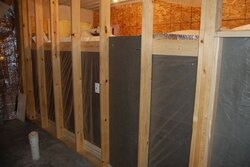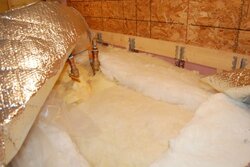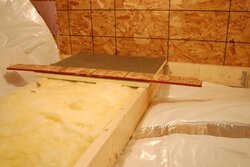#1 How Insulation is Made
Blown in Cellulose Insulation Fiberglass Insulation
Blown in cellulose insulation is made mostly from shredded newspaper and mixed with a variety of chemicals (up to 25% by weight) to reduce its flammibility. Fiberglass insulation is made by jetting molten glass through tiny heated holes in a high-speed stream. The resulting fibers are drawn very thin and to great length. The fibers are then
collected into a matte to produce fiberglass insulation.
#2 Blown in Cellulose vs Fiberglass Insulation in Performance
The R values between blown in cellulose insulation and fiberglass insulation are the same but the thickness varies. On average, blown in cellulose insulation is 2-3 inches thinner than fiberglass insulation when both have the same R values. Both blown in cellulose insulation and fiberglass insulation perform well to insulate your home. However, regardless of which insulation you choose, the performance of the insulation varies greatly on the quality of workmanship. This is generally true more so for cellulose insulation than fiberglass insulation. in addition cellulose insulation could cause some corrosion on metal that it touches but can also insulate the entire cavity of the wall and flow around wall studs while fiberglass insulation may not cause corrosion but it can not flow around wall stubs as it has to be placed there. However, this is generally not done.
#3 Home Insulation and Fires
Blown in Cellulose Insulation Fiberglass Insulation
Blown in cellulose insulation is treated for fire retardancy. If a fire occurs, the blown in cellulose insulation, combined with its fire retardants, can slow the fire from spreading and can create a "2-hour firewall". Scientists at the National Research Council of Canada report that, blown in cellulose insulation increases fire Fiberglass insulation is inert, ages well and is extremely difficult to ignite. However, once fiberglass insulation has been ignited, it may burn fast, hot and could emit toxic gases. Also, fiberglass insulation should be kept away from, light fixtures, chimneys or exhaust flu's to reduce heat build-up and potential fire hazards.
resistance by 22%-55%. When Blown in Cellulose insulation does burn, it generally doesn't emit toxic chemicals.
#4 Insulation Installation
Blown in Cellulose Insulation Fiberglass Insulation
When Installing cellulose insulation you will need special cellulose insulation equipment such as a cellulose insulation blower. Blown in cellulose insulation easily flows around obstructions and penetrates odd shaped cavities and it easily conforms around wires, electrical boxes and pipes. However, cellulose insulation is mixed with water and can take anywhere from 72 hours to over 1 year to completely dry. The drying Some fiberglass insulation facts on installation are: it has to be installed carefully, small fibers can cut your skin meaning you must wear protective equipment. Having to cut the fiberglass insulation to fit around wires, electrical boxes and pipes can be difficult and time consuming. Fiberglass batts are currently the standard insulation attributed to savings in residential and commercial buildings throughout the U.S.
time depends on the installation mix, moisture retarder, temperature, climate and when the drywall is installed.
#5 Blown in Cellulose vs Fiberglass Insulation Air Infiltration
Blown in cellulose insulation is 2-3 times denser than fiberglass insulation. Studies comparing Blown in cellulose insulation Vs fiberglass insulation show that cellulose insulation was 38% tighter and required 26% less energy. A Princeton University study shows, a group of homes with blown in cellulose insulation in the walls had an average of 24.5% reduction of air infiltration compared to fiberglass insulation, with only the walls insulated. A similar study, the Leominster MA Housing Project for the Elderly found that, a building with blown in cellulose insulation compared to a building with R-13 fiberglass batt insulation in the walls and R-38 fiberglass batt insulation in the ceiling, had 40% lower leakage. However, when it comes to air infiltration, sheathing and drywall are better air barriers than any cavity insulation. Air infiltration barriers such as high-density polyethylene membranes are installed for this specific purpose.
#6 Insulation and Moisture
Blown in Cellulose Insulation Fiberglass Insulation
A Blown in cellulose insulation vapor barrier is a must. Due to its chemical content, cellulose insulation may be more moisture resistant than fiberglass insulation. However, blown in cellulose insulation is mixed with water and if it is not given a proper drying time before the wall cavity is sealed up, studies show that it could retain the moisture in the insulation for over a year. Fiberglass insulation construction, allows water vapor to pass though its fibers. However, when water leaks through your wall with no drainage, fiberglass insulation may absorb the moisture and cause sags and gaps in the wall. These sags and gaps can allow heat in your house to escape. The end result would be, your r value is lower and your heating costs are higher.
There are currently no clear and reliable drying guidelines for cellulose insulation.
In genreal, insulation loses its r value when wet. Just 4% moisture can lower thermal effiecency, in that area, by up to 70%. Cellulose insulation fibers are naturally "hygroscopic". This means they are very effective at absorbing and retaining moisture. Moisture problems such as rot and mildew growth can occur when moisture remains above 20-25% for extended periods of time. It's recommended that you use a vapor barrier with both blown in cellulose insulation and fiberglass insulation applications. Preventing moisture/water leaks is a key factor in getting the best results for you home insulation. it's also important to allow internal moisture to escape. Dimpled membrane not only stops water and moisture from entering your home, but it allows water and moisture to escape. This dual action helps protect and lengthen the life of both blown in cellulose insulation and fiberglass insulation by letting your home breathe. No matter which insulation you choose, has you protected.




